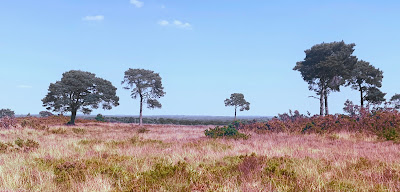Heath lands in Dorset.
The East Dorset heathland is not a natural habitat. The truth is that most heathlands are ancient landscapes that were created and maintained by people for over 4000 years.
The underlying geology of South East Dorset is Tertiary Sands created between 2 to 65 million years ago, bringing nutrient poor and well drained soils which already suited the development of lowland heaths.
By the Bronze Age (2500 - 800 BC) settlements were common on the the Dorset heaths. There were many Bronze Age settlements in Dorset with barrows, burial cremation chambers and standing stones (the Devils Stone - Bere Regis) which still remain on these heathland sites today.
By the middle of the Bronze Age (1) the ground had become as we see it today. Trees were cleared by Bronze Age farmers to make fields and the cleared wood was used for building homes, fences and shelter for livestock and fuel.
Removing trees and planting crops lead to a continuous increase in soil acidity and a reduction in the nutrient content. Gradually this lowered the fertility of the soil and farming became less viable. In the environmental change that followed the land became more favourable to gorse, heathers and heathland grasses. The landscape would have probably been dotted with silver birch and Scott’s Pine which managed to grow well in these soil conditions.
If the trees had not been felled in this way it is likely that the quick growth of birch would have blocked enough sunlight to the soil to cause the heathlands to eventually return as woodland. (2)
By the Iron Age (650 BC - AD 410) the heaths were largely unoccupied with the population moving towards the more fertile lands to the west for crop growing. The heathlands were still being used for grazing and fuel, but by the mid Iron Age local clays were also being used for pottery and the gorse used for the firing.
Early Iron Age potters used clay originally from the Southern Purbeck ridge, but by the first century the settlements were using the clays from around the Poole Harbour basin. The clay pits were adjacent to each other, from Broadstone to Upton where the beacon hill pits still rest underneath the current caravan site at beacon hill. There are surviving brickworks in use today near the area. (3)
The market for the pottery was probably increased with the arrival of the Romans, and many examples of black burnished ware pottery can be dated from this period.
Dorset heathland
Part 1 Part 2 Part 3 Part 4
Dorset heathland
Part 1 Part 2 Part 3 Part 4
(1) Social relations in later pre history by Niall Sharples OUP Oxford 2010
(2)What is heathland? http://www.countrysideinfo.co.uk/whatis.htm
(3) Sourcing the clay: Iron Age pottery production around Poole Harbour and the Isle of Purbeck, Dorset, UK - Grace Perpetua Jones (Bournemouth University)






No comments:
Post a Comment